Mars: Exploring the Red Planet's Past and Future
Mars, the fourth planet from the Sun, has captivated humanity for centuries. Its rusty appearance, due to iron oxide on its surface, gives it the nickname 'the Red Planet.' But Mars is more than just a reddish dot in the night sky; it's a world of immense scientific interest, holding potential clues to the past, present, and future of life in the universe.
A History of Observation
Ancient astronomers observed Mars and tracked its movements across the sky. It was named after the Roman god of war, reflecting its bloody hue. In the 17th century, telescopic observations began to reveal surface features, leading to speculation about the planet's environment.
Key Features of Mars
- Valles Marineris: A canyon system that stretches over 4,000 kilometers, dwarfing the Grand Canyon.
- Olympus Mons: The largest volcano and highest known mountain in our solar system.
- Polar Ice Caps: Composed primarily of water ice and carbon dioxide ice.
- Thin Atmosphere: Primarily carbon dioxide, with traces of nitrogen and argon.
The Search for Water
Evidence suggests that liquid water once flowed on Mars. Features like dried riverbeds and mineral deposits indicate a warmer, wetter past. Today, water exists primarily as ice, but the possibility of subsurface liquid water remains a key area of research. Understanding the history of water on Mars is crucial to understanding its potential for past or present life. Scientists are using data from rovers and orbiters to analyze Martian soil and rock samples for signs of water and organic molecules.
Past and Present Missions
Dozens of missions have been sent to Mars, each contributing to our understanding of the planet. From the Viking landers in the 1970s to the Curiosity and Perseverance rovers of today, these missions have provided invaluable data and imagery. Orbiters like the Mars Reconnaissance Orbiter provide high-resolution images and atmospheric data. The InSight lander studies the planet's interior, providing insights into its geological activity. Future missions are planned to bring Martian samples back to Earth for detailed analysis.
The Future of Mars Exploration
The long-term vision for Mars exploration includes the possibility of human missions. NASA, SpaceX, and other organizations are developing technologies for landing, living, and working on Mars. Key challenges include radiation protection, resource utilization (like extracting water from ice), and growing food. Colonizing Mars could provide a backup plan for humanity and open up new frontiers for scientific discovery.
The Significance of Mars
Exploring Mars is about more than just scientific curiosity; it's about understanding our place in the universe. By studying Mars, we can learn more about the conditions necessary for life to arise and evolve. We can also gain insights into the potential for life beyond Earth. Mars represents a challenging but potentially rewarding destination for future exploration, offering the chance to expand our knowledge and push the boundaries of human achievement.
Long-Tail Keywords
- Evidence of water on Mars
- Future human missions to Mars
- Geological features of Mars
- Past Mars exploration missions
- Challenges of colonizing Mars









